PART1
PRESENT STATUS
Chapter 1 Women's Participation in Policy Decision-Making Processes
Women's Participation in Policy Decision-Making Processes in Public Areas
Areas in which gender equality needs to be realized
- A survey targeting 3,000 intellectuals nationwide asked the question, "In which area(s) does gender equality need to be realized in order to bring about a gender-equal society?" In response to this, the highest percentage, 46.4%, answered, "Gender equality in the policy decision-making processes of central and local governments," while the next highest percentage, 43.1%, answered, "Securing equal treatment for men and women in the workplace." (Figure 1)
Figure 1: Areas in which gender equality should be realized (Multiple response)

Source:
Survey on a Gender Equal Society September 1998, Prime Minister's Office
Present state of Japan in human development-related indices
According to the United Nations Development Programme (UNDP) Human Development Report 1998, the indices developed* by the UNDP rank Japan eighth in the world in terms of the Human Development Index (HDI), 13th on the Gender-Related Development Index (GDI), and, far lower in comparison with HDI and GDI rankings, 38th on the Gender Empowerment Measure (GEM).
In terms of changes in HDI, GDI and GEM point values of Japan and other countries, the United Kingdom shows the highest climb in GEM, up 0.110 points, followed by Australia, up 0.096 points (Figure 2). In HDI and GEM, Japan had the lowest increase of these countries.
Figure 2: 1995-1998 HDI, GDI and GEM changes by country

Notes:
Figures shown equal the 1995 (1996) HDI, GDI and GEM values subtracted from 1998 values.
Source:
Human Development Report 1995 and 1998, United Nations Development Programme (UNDP)
*Source for GDI and GEM of Germany: Same report, 1996 and 1998
- Human Development Index: HDI
-
HDI is a composite index which measures the degree to which basic human capabilities have been extended on average, with the three principal criteria of "healthy lifestyle allowing longevity," "knowledge" and "average living standard." Specific factors from which HDI is calculated include average life expectancy, education attainment (adult literacy rates and school attendance) and adjusted real GDP per capita.
- Gender-Related* Development Index: GDI
-
While GDI is similar to HDI in that it represents the degree to which basic capabilities have been extended, GDI focuses on the inequality factor reflected in men's and women's respective levels.
Like HDI, GDI is also based on average life expectancy, education attainment and GDP, deducting, however, disparities between men and women as a penalty. GDI could therefore be defined as HDI adjusted for gender inequality.
* The term "gender" distinguishes the sexes on a social and cultural basis, as opposed to "sex," which is based on biological factors. - Gender Empowerment* Measure: GEM
-
GEM evaluates whether or not women are able to participate actively in economic and political activities and take part in decision-making. While HDI and GDI focus on the extension of capabilities, GEM looks principally at whether such capabilities can be utilized and whether advantage can be taken of the various opportunities in life.
Specific factors used in calculating GEM include women's share of earned income, the ratio of female professional and technical workers, the ratio of female administrators and managers, and the ratio of seats in parliament held by women.
* "Empowerment" means "to give power," and specifically refers to raising one's consciousness and capabilities to become a powerful political, economic, social and cultural presence.
- Four factors for calculating GEM point values are the ratio of seats in parliament held by women, the ratio of female administrators and managers, the ratio of female professionals and technical workers and women's share of earned income. Looking at the point values of countries, Sweden and Norway, which both have high GEM point values, maintain a clear balance between the four elements and form a diamond-shape in Figure 3 below, whereas France, Japan and the Republic of Korea, in which the ratio of women parliamentarians and the ratio of women in government and managerial positions is low, form an inclined trapezoid (Figure 3).
Figure 3: Changes in four factors for calculating GEM by country

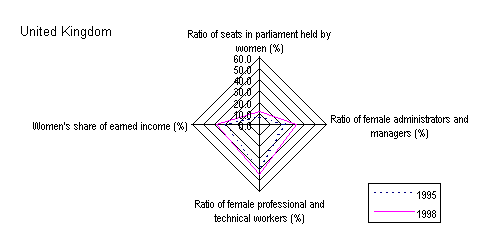
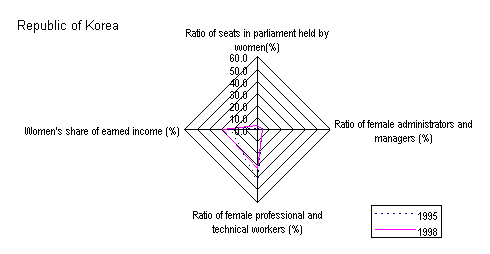
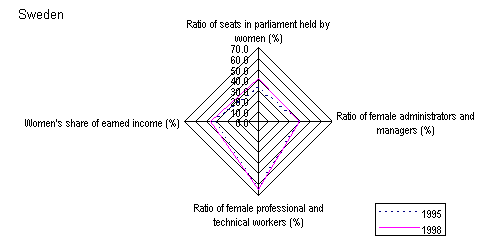
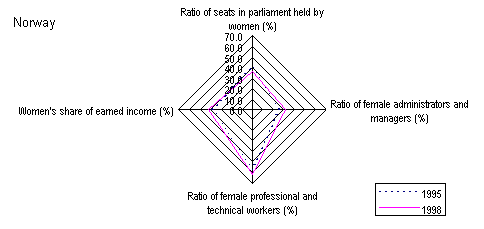
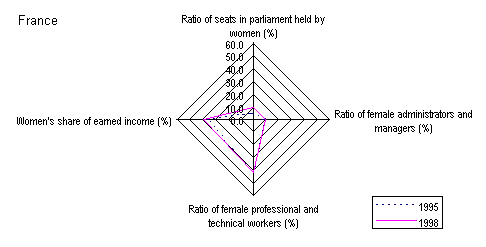
Source:
Human Development Report 1995 and 1998, United Nations Development Programme (UNDP)
